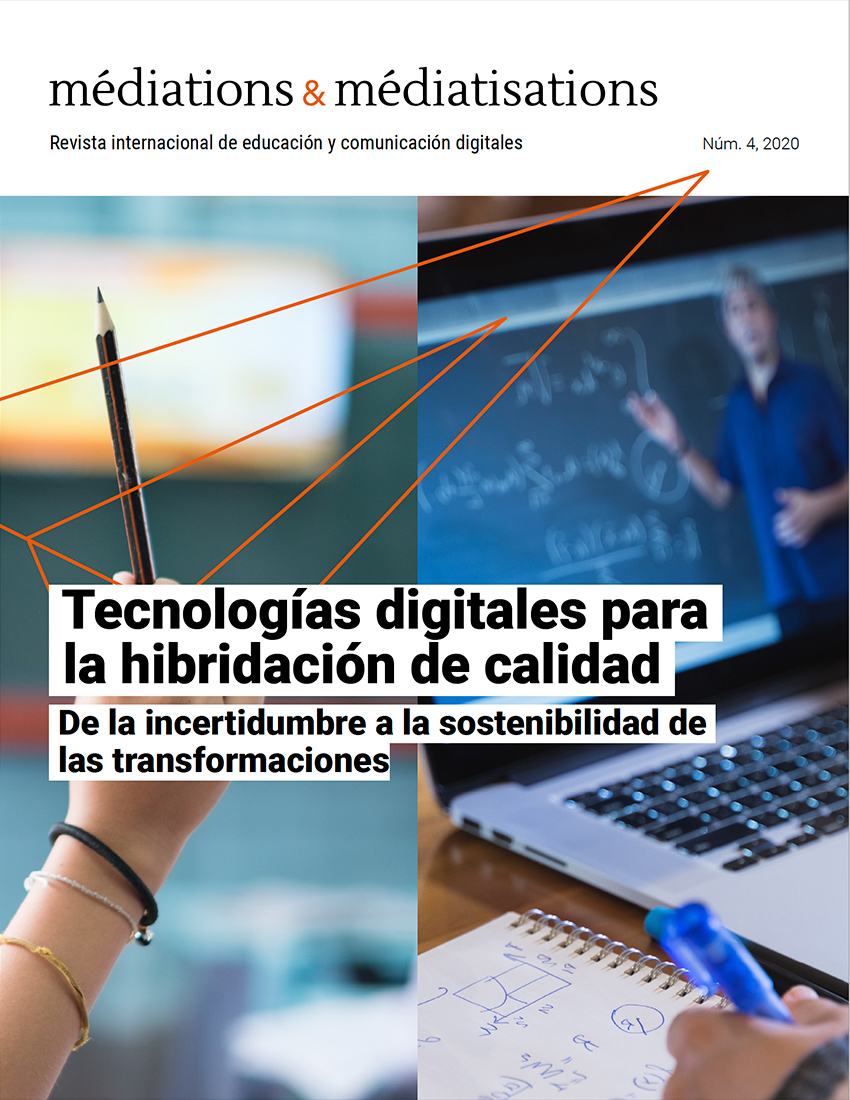Diseñar un aula dedicada a la formación de docentes en el siglo XXI: Reflexiones de un proyecto interdisciplinario en un contexto universitario
Contenido principal del artículo
Resumen
El proyecto Classe du futur tiene como objetivo repensar las aulas en la formación inicial y continua de los docentes. Este proyecto se inscribe en el deseo de proporcionar espacios de aprendizaje flexibles en la universidad mientras se prepara a los profesores para los desafíos del siglo XXI. A través de un esfuerzo concertado, estudiantes de las ciencias del diseño y de la educación propusieron un esbozo de diseño para espacios existentes en el campus de la UQAM. El esbozo presentado en este artículo permite también reflexionar sobre el interés de los proyectos de investigación interdisciplinarios y sobre las características de un clase de aprendizaje activo en la universidad.
Descargas
Detalles del artículo

Esta obra está bajo una licencia internacional Creative Commons Atribución-NoComercial-CompartirIgual 4.0.
Citas
Anderson, L. et Krathwohl, D. A. (2001). Taxonomy for Learning, Teaching and Assessing: A Revision of Bloom’s Taxonomy of Educational Objectives. Longman.
Barrett, P., Zhang, Y., Davies, F. et Barrett, L. (2015). Clever Classrooms: Summary Report of the HEAD Project. Université de Salford. https://usir.salford.ac.uk/id/eprint/35221/
Beaudoin, J. (2013). Introduction aux pratiques d’enseignement inclusives. Université d’Ottawa. https://www.uottawa.ca/respect/sites/www.uottawa.ca.respect/files/accessibilite-guide-inclusion-fr-2013-10-30.pdf
Bonwell, C. et Eison, J. A. (1991). Active Learning : Creating Excitement in the Classroom (ASHE-ERIC Higher Education Report No. 1). The George Washington University, School of Education and Human Development. https://files.eric.ed.gov/fulltext/ED336049.pdf
Céci, J. et Coudrin, D. (2014). (Re)penser les espaces physiques d'apprentissage. Fédération Interuniversitaire de l’Enseignement à Distance. https://doi.org/10.13140/RG.2.2.27110.11841
Chamberland, G., Lavoie, L. et Marquis, D. (1995). 20 formules pédagogiques. Presses de l’Université du Québec.
Cleveland, B. J. (2011). Engaging spaces: Innovative learning environements, pedagogies and student engagement in the middle years of school [Thèse de doctorat]. Université de Melbourne. https://pdfs.semanticscholar.org/e602/1e9e1df68311a7374a600c9ec3fb69a9b700.pdf
Collège LaSalle. (2020). Salles de classe actives. https://www.collegelasalle.com/a-propos/installations-specialisees/salles-de-classe-actives
Dede, C. (2010). Technological supports for acquiring 21st century skills. Dans E. Baker, B. McGraw et P. Peterson (dir.), International Encyclopedia of Education (3 éd., p. 158-166). Elsevier.
Delacourt, S. (2019). L'artiste-chercheur: Un rêve américain au prisme de Donal Judd. Éditions B42.
Ertmer, P. et Ottenbreit-Leftwich, A. (2013). Removing obstacles to the pedagogical changes required by Jonassen's vision of authentic technology-enabled learning. Computers & Education, 64, 1-8. https://doi.org/10.1016/j.compedu.2012.10.008
Ertmer, P., Ottenbreit-Leftwich, A. et Tondeur, J. (2015). Teachers’ beliefs and uses of technology to support 21st-century teaching and learning. Dans H. Fives et G. Michele (dir.), International handbook of research on teacher beliefs (p. 403-418). Routledge.
Fournier St-Laurent, S., Normand, L., Bernard, S. et Desrosiers, C. (2018). Les conditions d’efficacité des classes d’apprentissage actif. Collège Ahuntsic. https://eduq.info/xmlui/bitstream/handle/11515/35536/fournier-st-laurent-et-al-conditions-efficacite-classes-apprentissage-actif-parea-2018.pdf
Freeman, S., Eddy, S. L., McDonough, M., Smith, M. K., Okoroafor, N., Jordt, H. et Wenderoth, M. P. (2014). Active learning increases student performance in science, engineering, and mathematics. Proceedings of the National Academy of Sciences, 111(23), 8410-8415. https://doi.org/10.1073/pnas.1319030111
Global Partnership for Education (2020). 21st-Century Skills: What potential role for the Global Partnership for Education? A Landscape Review. GPE. https://www.globalpartnership.org/content/21st-century-skills-what-potential-role-global-partnership-education
Joynes, C., Rossignoli, S. et Amonoo-Kuofi, E. F. (2019). 21st Century Skills: evidence of issues in definition, demand and delivery for development contexts (K4D Helpdesk Report). Institute of Development Studies. https://assets.publishing.service.gov.uk/media/5d71187ce5274a097c07b985/21st_century.pdf
LearningLab Network. (2019). Les cahiers du Learning Lab Network. LearningLab Network. http://www.learninglab- network.com/wp-content/uploads/2019/06/Cahier_LLN_1.pdf
Lewin, C. et McNicol, S. (2015). Supporting the development of 21st century skills through ICT. In T. Brinda, N. Reynolds, R. Romeike et A. Schwill (dir.), KEYCIT 2014 : Key competencies in informatics and ICT (p. 98-181). University of Potsdam. https://publishup.uni-potsdam.de/opus4-ubp/frontdoor/deliver/index/docId/7032/file/cid07.pdf
McDaniel, S. (2014). Every Space is a Learning Space : Encouraging informal learning and collaboration in higher education environments. BWBR. https://www.bwbr.com/wp-content/uploads/2020/10/Every-Space-Is-A-Learning-Space_WP.pdf
McGill. (2020). Active Learning Classrooms (ALCs). https://www.mcgill.ca/tls/spaces/alc
Normand, L. (2017). L’apprentissage actif: une question de risques… calculés. Pédagogie collégiale, 31(1), 5-12. http://aqpc.qc.ca/sites/default/files/revue/normand-vol.31-1.pdf
Osguthorpe, R. T. et Graham, C. R. (2003). Blended learning environments : Definitions and directions. The Quarterly Review of Distance Education, 4(3), 227-233. https://www.learntechlib.org/p/97576/
Paquelin, D. (2017). Flexibilisation : principes et actions. Site du Bureau de soutien à l’enseignement de l’Université Laval. https://www.enseigner.ulaval.ca/sites/default/files/01-flexibilisation_mai_2017.pdf
Paquin, L. C. (2014). La recherche. Méthodologie de la recherche création. http://lcpaquin.com/metho_rech_creat/index.html
Prince, M. (2004). Does Active Learning Work? A Review of the Research. Journal of Engineering Education, 93(3), 1-9. https://doi.org/10.1002/j.2168-9830.2004.tb00809.x
Shishegar, N. et Boubekri, M. (2016, avril). Natural light and productivity: Analyzing the impacts of daylighting on students’ and workers’ health and alertness. Communication présentée à l’International Conference on “Health, Biological and Life Science”, Istanbul, Turquie. https://www.researchgate.net/publication/303484362_Natural_Light_and_Productivity_Analyzing_the_Impacts_of_ Daylighting_on_Students'_and_Workers'_Health_and_Alertness
Singh, H. (2003). Building effective blended learning programs. Educational Technology, 43(6), 51-54. http://asianvu.com/digital-library/elearning/blended-learning-by_Singh.pdf
Tondeur, J., Aesaert, K., Prestridge, S. et Consuegra, E. (2018). A multilevel analysis of what matters in the training of pre- service teacher's ICT competencies. Computers & Education, 122, 32-42. https://doi.org/10.1016/j.compedu.2018.03.002
Université Laval. (2013). Repenser les espaces physiques d’apprentissage : Orientations stratégies et pédagogiques.
Université Laval. https://www.enseigner.ulaval.ca/system/files/espaces_physiques-orientations_strategiques_0.pdf
Valdès, D. (1995). Vers de nouvelles formes de formations : Les formations hybrides (Mémoire de DESS, Université de Paris 2).

